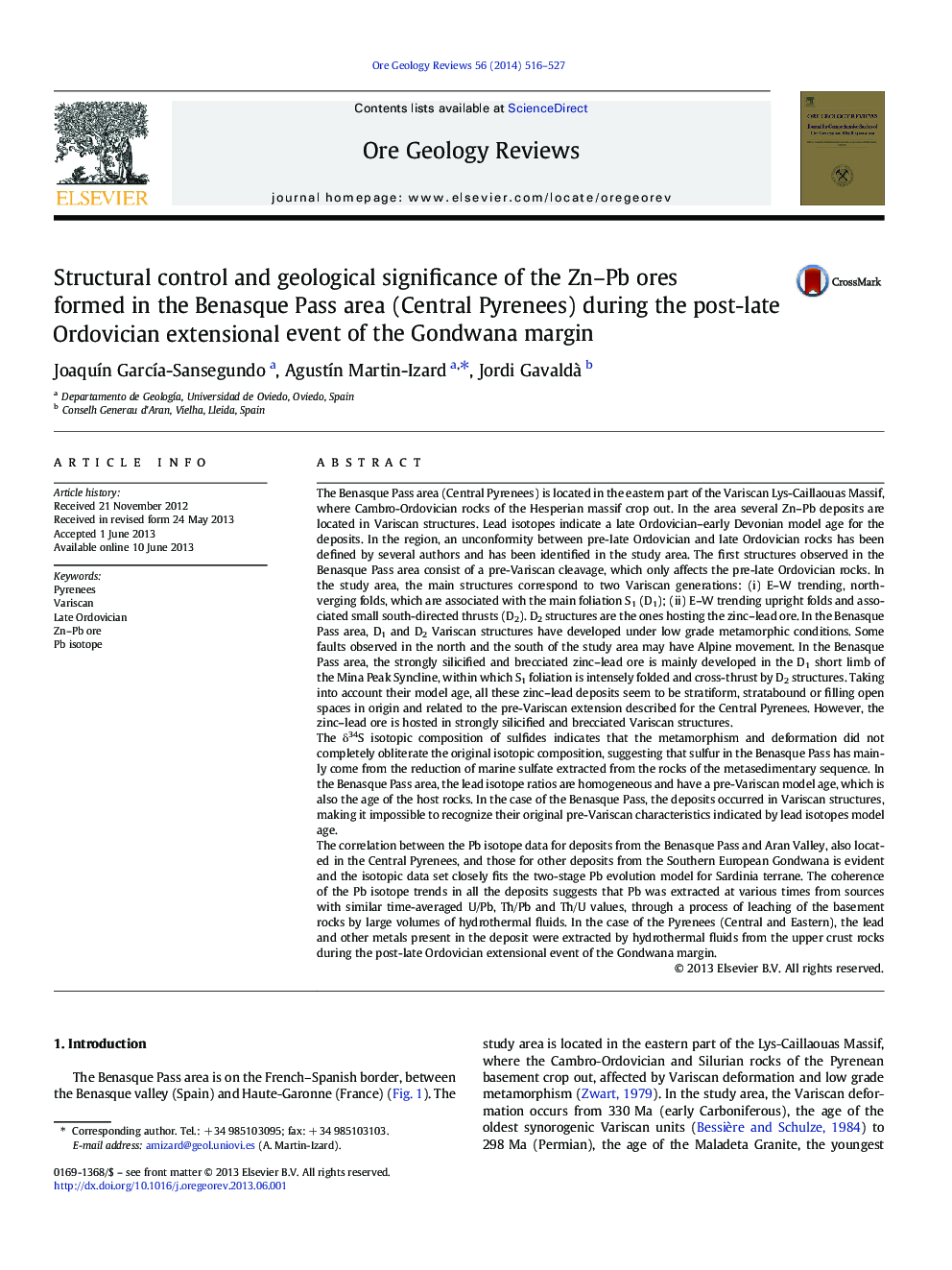| کد مقاله | کد نشریه | سال انتشار | مقاله انگلیسی | نسخه تمام متن |
|---|---|---|---|---|
| 4697450 | 1637247 | 2014 | 12 صفحه PDF | دانلود رایگان |

• Zn-Pb ores in the Central Pyrenees are related to the Ordovician - Devonian extension.
• Zn-Pb ores are within Variscan thrusts developed sub-parallel to S1 and normal to S0.
• The ages estimated using lead isotopes indicate a Ordovician - Devonian model age
• Original ores may be stratiform or fill spaces and were remobilized in Variscan times.
• Pb isotope data for deposits from the Gondwana fits the Sardinia Pb evolution model.
The Benasque Pass area (Central Pyrenees) is located in the eastern part of the Variscan Lys-Caillaouas Massif, where Cambro-Ordovician rocks of the Hesperian massif crop out. In the area several Zn–Pb deposits are located in Variscan structures. Lead isotopes indicate a late Ordovician–early Devonian model age for the deposits. In the region, an unconformity between pre-late Ordovician and late Ordovician rocks has been defined by several authors and has been identified in the study area. The first structures observed in the Benasque Pass area consist of a pre-Variscan cleavage, which only affects the pre-late Ordovician rocks. In the study area, the main structures correspond to two Variscan generations: (i) E–W trending, north-verging folds, which are associated with the main foliation S1 (D1); (ii) E–W trending upright folds and associated small south-directed thrusts (D2). D2 structures are the ones hosting the zinc–lead ore. In the Benasque Pass area, D1 and D2 Variscan structures have developed under low grade metamorphic conditions. Some faults observed in the north and the south of the study area may have Alpine movement. In the Benasque Pass area, the strongly silicified and brecciated zinc–lead ore is mainly developed in the D1 short limb of the Mina Peak Syncline, within which S1 foliation is intensely folded and cross-thrust by D2 structures. Taking into account their model age, all these zinc–lead deposits seem to be stratiform, stratabound or filling open spaces in origin and related to the pre-Variscan extension described for the Central Pyrenees. However, the zinc–lead ore is hosted in strongly silicified and brecciated Variscan structures.The δ34S isotopic composition of sulfides indicates that the metamorphism and deformation did not completely obliterate the original isotopic composition, suggesting that sulfur in the Benasque Pass has mainly come from the reduction of marine sulfate extracted from the rocks of the metasedimentary sequence. In the Benasque Pass area, the lead isotope ratios are homogeneous and have a pre-Variscan model age, which is also the age of the host rocks. In the case of the Benasque Pass, the deposits occurred in Variscan structures, making it impossible to recognize their original pre-Variscan characteristics indicated by lead isotopes model age.The correlation between the Pb isotope data for deposits from the Benasque Pass and Aran Valley, also located in the Central Pyrenees, and those for other deposits from the Southern European Gondwana is evident and the isotopic data set closely fits the two-stage Pb evolution model for Sardinia terrane. The coherence of the Pb isotope trends in all the deposits suggests that Pb was extracted at various times from sources with similar time-averaged U/Pb, Th/Pb and Th/U values, through a process of leaching of the basement rocks by large volumes of hydrothermal fluids. In the case of the Pyrenees (Central and Eastern), the lead and other metals present in the deposit were extracted by hydrothermal fluids from the upper crust rocks during the post-late Ordovician extensional event of the Gondwana margin.
Figure optionsDownload as PowerPoint slide
Journal: Ore Geology Reviews - Volume 56, January 2014, Pages 516–527